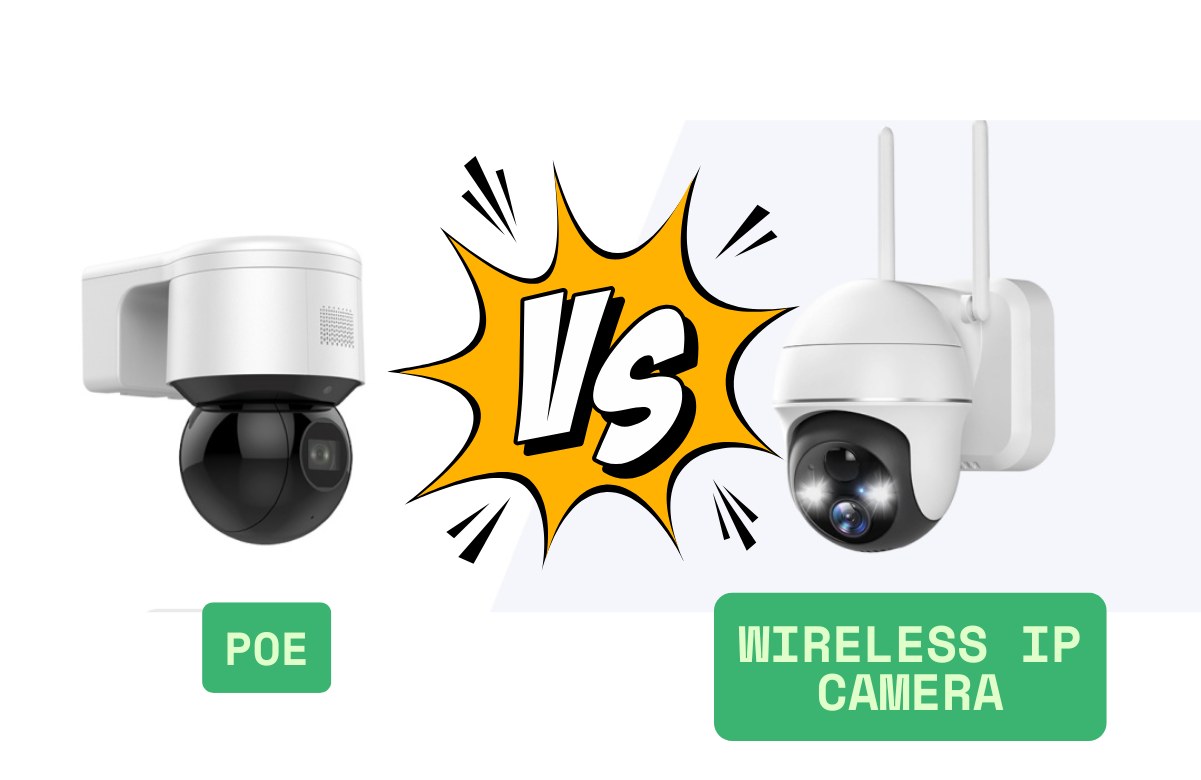PoE vs Wireless IP Camera - Which One Should You Choose in 2025?

Are you tired of blurry videos and security cameras that don’t work when you need them most? When it comes to keeping your home or business safe, two types of cameras are popular: PoE (Power over Ethernet) and Wireless IP cameras. But which one is better for you?
Choosing between PoE and WiFi cameras can feel overwhelming. You want a system that’s reliable, easy to set up, and gives you clear video footage. With so many choices, how do you pick the right one to protect your property? Don’t stress – Trimatrik Multimedia is here to help! In this blog, we’ll break down the differences between PoE and WiFi cameras. We’ll compare their pros and cons so you can make the best decision for your needs.
We’ll also share the key features to look for and explain why both types of cameras are great for security. Whether you’re a homeowner or a business owner, this guide will give you the knowledge to choose the perfect camera. Let’s dive in!
At Trimatrik Multimedia, we’ve been helping customers across Bangladesh with top-quality security solutions for years. From CCTV cameras to access control systems, our expert team ensures you get the best products and support. Stay tuned to learn more!
PoE vs WiFi Cameras: A Head-to-Head Comparison
When choosing between PoE (Power over Ethernet) and WiFi cameras, it’s important to understand their differences. Both have pros and cons, and your choice depends on your needs. Let’s break it down in simple terms.
A. Network reliability and transmission range
When comparing PoE and WiFi cameras, network reliability and transmission range are crucial factors to consider. PoE cameras offer superior reliability due to their wired connectivity, reducing the risk of network outages and latency. This results in smoother live feeds, ensuring you don't miss any critical moments in your surveillance.
In terms of transmission range:
- PoE cameras: Support a maximum distance of 100 meters
- WiFi cameras: Limited to around 10 meters from the router
This significant difference in range makes PoE cameras more suitable for large-scale surveillance applications, while WiFi cameras are better suited for smaller spaces or homes.
B. Power supply and functionality during outages
One of the key advantages of PoE cameras is their power supply method:
|
Feature |
PoE Cameras |
WiFi Cameras |
|
Power Source |
Ethernet cable |
Separate power source or batteries |
|
Functionality during outages |
Maintained (with backup power) |
May be interrupted |
|
Installation complexity |
Simplified (single cable) |
May require multiple cables or battery changes |
PoE cameras draw power through the Ethernet cable, simplifying installation and ensuring continuous operation even during power failures (when connected to a backup power source). WiFi cameras, on the other hand, may require periodic battery recharging or separate power connections, which can disrupt your surveillance if not managed properly.
C. Installation complexity and flexibility
While PoE cameras offer enhanced reliability, they do come with more complex installation requirements:
- PoE cameras: Require professional knowledge and more intricate wiring
- WiFi cameras: User-friendly and easier to install for non-professionals
WiFi cameras provide greater flexibility in terms of placement and integration with smart home devices. However, this ease of installation comes at the cost of potential signal interference and bandwidth limitations.
D. Security and vulnerability to cyber threats
When it comes to security, PoE cameras have a distinct advantage:
- PoE cameras: Less vulnerable to cyber threats due to wired connections
- WiFi cameras: More susceptible to hacking and interference
WiFi cameras operate on your home network, making them potentially more vulnerable to cyber-attacks. It's crucial to implement strong security measures, regardless of the camera type you choose, to protect your surveillance system from potential threats.
With this comparison in mind, next, we'll explore the key factors you should consider before choosing between PoE and WiFi cameras. This will help you make an informed decision based on your specific needs, budget, and installation conditions.
Key Factors to Consider Before Choosing Between PoE and WiFi Cameras
Now that we've compared PoE and WiFi cameras head-to-head, let's explore the key factors you should consider before making your choice.
A. Specific surveillance needs and environment
Your surveillance requirements and the environment where you'll install the cameras play a crucial role in your decision. Consider the following:
- Coverage area: PoE cameras support a transmission distance of up to 100 meters, while WiFi cameras typically have a range of about 10 meters from the router.
- Reliability: PoE cameras offer more stable connections, ideal for constant surveillance in businesses or large properties.
- Interference: WiFi cameras are susceptible to signal interference from physical obstacles and electronic devices.
B. Budget constraints
Your budget will significantly influence your choice:
|
Factor |
PoE Cameras |
WiFi Cameras |
|
Initial cost |
Higher due to specialized equipment |
Generally more budget-friendly |
|
Installation cost |
May require a professional setup |
Often easier for DIY installation |
|
Long-term costs |
Potentially lower maintenance costs |
May incur costs for battery replacement |
C. Installation conditions and expertise
Consider your installation environment and technical know-how:
- Wiring: PoE cameras require Ethernet cable installation, which can be complex but offers a cleaner look.
- Flexibility: WiFi cameras provide easier placement options, ideal for renters or frequently changing layouts.
- Technical knowledge: PoE systems may need professional installation, while WiFi cameras are more user-friendly.
D. Desired features and functionality
Both PoE and WiFi cameras offer similar features, but some differences exist:
- Video quality: PoE cameras often support higher resolutions and smoother live feeds.
- Remote access: Both types allow remote monitoring, but WiFi cameras may integrate more easily with smart home devices.
- Power management: PoE cameras can use centralized backup power, ensuring functionality during power failures.
- Scalability: PoE systems can accommodate more cameras without degrading network performance.
With these factors in mind, you'll be better equipped to choose between PoE and WiFi cameras. Next, we'll explore the shared features of both camera types, highlighting what they have in common to further aid your decision-making process.
Shared Features of PoE and WiFi Cameras: What They Have in Common
Now that we've explored the key factors to consider when choosing between PoE and WiFi cameras, let's delve into the shared features that both these types of IP cameras have in common. Understanding these similarities will help you appreciate the core functionalities that you can expect, regardless of which option you choose.
Motion Detection Capabilities
Both PoE and WiFi IP cameras come equipped with motion detection capabilities, enhancing your surveillance system's efficiency. This feature allows you to:
- Receive alerts when movement is detected in specific areas
- Reduce unnecessary footage by only recording when motion occurs
- Customize sensitivity levels to avoid false alarms
Night Vision Functionality
Whether you opt for a PoE or WiFi camera, you'll benefit from night vision functionality. This essential feature ensures:
- 24/7 surveillance, even in low-light conditions
- Clear visibility of potential security threats after dark
- Enhanced safety for your property during nighttime hours
Remote Access and Monitoring
One of the most significant advantages of modern IP cameras is their remote accessibility. Both PoE and WiFi cameras offer:
- Real-time viewing of live footage from any internet-connected device
- Ability to manage and control your cameras from anywhere
- Instant alerts and notifications sent directly to your smartphone or tablet
|
Feature |
PoE Cameras |
WiFi Cameras |
|
Motion Detection |
✓ |
✓ |
|
Night Vision |
✓ |
✓ |
|
Remote Access |
✓ |
✓ |
These shared features demonstrate that regardless of your choice between PoE and WiFi cameras, you'll have access to advanced surveillance capabilities. Both types offer robust security solutions with the flexibility to monitor your property remotely. As you consider your options, remember that these core functionalities form the foundation of any modern IP camera system, ensuring that you're well-equipped to protect your home or business.
Final Thoughts: PoE or WiFi Cameras
When deciding between PoE (Power over Ethernet) and WiFi cameras for your security needs, it’s important to understand the benefits of each. PoE cameras are known for their strong network connection, long-range transmission, and constant power supply. They are perfect for places that need 24/7 monitoring, like offices or large properties. On the other hand, WiFi cameras are easier to install and offer more flexibility, making them a great choice for smart homes or smaller spaces.
At Trimatrik Multimedia, we help you choose the right system based on your needs, budget, and setup. Whether you go for the reliable performance of PoE cameras or the convenience of WiFi cameras, both options come with essential features like motion detection and night vision.
No matter which system you pick, always focus on cybersecurity. This ensures your cameras stay safe from hackers and work effectively to protect your home or business.
With years of experience, Trimatrik Multimedia has helped countless customers in Bangladesh find the best security solutions. We offer top-quality brands like Hikvision and Dahua, along with expert advice and genuine products you can trust. Whether you need a PoE or WiFi camera, we’re here to make your security setup simple and reliable.
Choose Trimatrik Multimedia for trusted, high-quality security solutions that keep you and your property safe!



